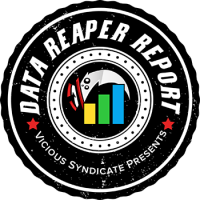
Welcome to the 193rd edition of the Data Reaper Report!
Contributing to the Data Reaper project through Hearthstone Deck Tracker or Firestone allows us to perform our analyses and to issue the weekly reports, so we want to wholeheartedly thank our contributors. Without the community’s contributions, there would be no project. Contributing data is very easy, so if you enjoy our content and would like to make sure it remains consistent and free – Sign up!
Quick Links
Class/Archetype Distribution | Class Frequency | Matchup Winrates | vS Power Rankings | vS Meta Score | Class Analysis & Decklists | Meta Breaker of the Week | How to Contribute | Credits
Number of Games
| Overall | 380,000 |
| Top 1K Legend | 14,000 |
| Legend (Excluding Top 1k) | 79,000 |
| Diamond 4 to 1 | 74,000 |
| Diamond 10 to 5 | 77,000 |
| Platinum | 52,000 |
| Bronze/Silver/Gold | 84,000 |
Class/Archetype Distribution
[TABS_PRO id=46728]
Class Frequency
[TABS_PRO id=46729]
Class Frequency Discussion
The frequency graphs for this report are very striking. The first thing that’s important to notice is that the top legend field, which tends to be more developed (especially after a patch that shook up the meta), is extremely diverse. The most popular class sits at a 14% play rate, while the 8th most popular class is at 9.5%. The most popular deck makes up 10% of the field. An overwhelming force could still take over the meta, but the fact it hasn’t happened yet is encouraging.
Paladin may have eaten a couple of nerfs, but the class is still going strong throughout ladder. Secret and Libram Paladin remain very visible, with the aggressive archetype now looking more popular, but a new Aggro Paladin archetype has emerged omitting the Secret package. Much like most new developments, it’s more visible at top legend and is in the process of trickling down.
Hunter has also looked strong, with Face Hunter emerging into the scene before the patch, but exploding at its launch. The deck is particularly popular at the high Diamond bracket, where it makes up nearly 20% of the field.
Control Warlock is another deck that received much fanfare and publicity following the balance changes, becoming one of the most popular decks in the format. Is Tickatus finally becoming the meta tyrant many feared it would be? Have the balance changes opened up a path for it to dominate?
Spell Mage’s play rate has fallen off a cliff, but the deck is still quite common throughout ladder, with Deck of Lunacy beginning to disappear from builds. Is it the right call? Stay tuned. Other archetypes do not see much play, with the most noticeable one being Spell-Damage Mage, now running Kazakus.
Demon Hunter is mainly comprised of three archetypes. The first is Inquisitor Demon Hunter, which is the hard-hitting Kazakus deck that previously played Watch Posts. This deck was hyped quite a bit on patch day with “Green Rag” receiving much praise. The second most popular deck is Lifesteal Demon Hunter, seeking a return to the format on the back of Mage and Paladin’s decline. Of course, its presence is highest at top legend, as always. The third is Deathrattle Demon Hunter. Aggro and Soul DH see very little play.
Warrior has made its return to Hearthstone, with the newly emerging Rush Warrior looking to take advantage of minion combat becoming a core part of Hearthstone gameplay once again. We can see its play rate trickling down from top legend, where it is the most popular deck in the field. This is a very promising sign regarding its potential viability. Control Warrior is still looking fairly niche in comparison, with nothing taking off so far.
Priest is another class that sees more play at higher levels, which may have something to do with the correlating decline of Control Warlock, its oppressive matchup. Control Priest builds are very diverse and experimental, while being split on C’Thun. Miracle Priest has a more modest representation.
Druid seems very quiet these days. We can find Gibberling Druid boasting a modest play rate, but not much else is going on. There’s very little of Clown Druid, as well as the meme-tastic Celestial Druid, which is known for its astounding win rate that sank deep into the 30’s before the patch.
Rogue gradually sees more play as you climb ladder and dramatically peaks at top legend. Its state of refinement is also drastically different between rank brackets, especially when it comes to Miracle Rogue. Both Miracle and Secret Rogue have begun to utilize the Alex/Tenwu combo after losing their Pen Flinger damage. The other Rogue archetype that is noticeable on ladder is Poison Rogue.
Shaman looks like a dead class, attracting no interest amongst the player base. Is there a gem to find within the Barrens, or is its play rate truly reflective of its viability? We’ll find out right about now.
[TABS_PRO id=46730]

[TABS_PRO id=46731]
vS Meta Score
[TABS_PRO id=46732]
vS Power Rankings Discussion
This feels like the first real report of Forged in the Barrens. There’s much to explore in the landscape, and many questions have yet to be answered. We cannot just fixate on current win rates in order to understand the power level of decks, but have to consider future trends: where matchups are headed and how much decks can improve. At first glance, it seems that aggressive decks are dominating the format, but there’s more to it than meets the eye. Let’s dig in.
- Paladin
- Paladin still looks very powerful, especially the aggressive archetypes of Aggro and Secret. It’s interesting to note that Aggro Paladin is currently outperforming Secret Paladin, though it’s still too early to tell what’s going to be the superior choice going forward since both decks are still developing. Both exhibit insanely good matchup spreads with incredible overall win rates. So, is Paladin still broken?
- Perhaps not. Digging deeper into matchups and evaluating future meta trends tells us that Paladin’s win rate should significantly go down. It currently benefits from beating overplayed decks that are very weak, while newly emerging archetypes that show a lot of promise are developing significant edges against Paladin. Warrior, Rogue, and Priest (when optimized) all promise to become very effective counters to Paladin. The meta has answers and it’s all about those answers gaining traction throughout ladder to knock Uther down. There is no Tier S deck here, the meta isn’t stuck and players have good options available to them. We actually expect that Paladin will be knocked off Tier 1 within the next two weeks at top legend. It will still be very strong throughout ladder, but it’s not going to be unstoppable.
- Libram Paladin’s matchups also tell us how effective the nerf to Pen Flinger has been. The loss of its infinite damage now makes it vulnerable to removal by heavy control decks, such as Priest and Warlock. It has retained many of its strengths as well as its playstyle, but it’s no longer a deck that’s strong at everything.
- Hunter
- Face Hunter currently looks very good, but it’s a deck that’s losing ground at a more accelerated pace compared to Paladin. It’s already been knocked off Tier 1 at top legend, as refinement is making its opposition more efficient. Face Hunter was perfectly refined on the day of the patch and had a head start. When you also look at its matchup spread, you see it benefitting from beating the same bad decks Paladin is beating. On the other hand, its matchup spread at legend already suggests it is in the process of getting heavily countered. Unless Hunter adjusts, it might be in danger of falling off quite dramatically at higher levels, and this process will trickle down as well. Warrior, Priest, and Paladin are going to be major issues for the class going forward.
- Warlock
- Once again, Control Warlock proves to be a fraud. Its matchup spread is horrendous, and becomes noticeably worse at higher levels. The deck’s sole competitive future is its utilization as a Priest counter, which funnily enough, could be relevant. Control Warlock’s somewhat reasonable win rate at top legend is the result of the popularity of Priest, and the reduced presence of decks that utterly destroy it. There’s no chance of Control Warlock becoming a strictly good deck for ladder, but it could end up seeing fringe competitive play. The question is, will Warlock’s horrid win rate throughout ladder result in a decline in its play rate, or is the deck too fun for some players, or perceived to be good by others, for it not to maintain such popularity?
- Mage
- Spell Mage’s situation is quite fascinating. Currently, it is getting completely destroyed on the climb to legend due to the popularity of Hunter and Paladin, but its performance at legend suggests it could end up being very strong going forward. With the nerf to Lunacy, its matchups against aggressive decks have gotten worse, but it has retained good matchups against many other strong decks in the field. If Hunter falls off as we expect it to, Spell Mage could become a top contender once again. In addition, the archetype is significantly hurt by the fact that many builds have persisted with Deck of Lunacy, and we can confidently tell you that the card should be cut. The nerf to Lunacy may have killed the card from a competitive standpoint, but the deck itself will not die. This is good news for many players who enjoy Spell Mage.
- Spell-Damage Mage is not looking too good, and neither does any other Mage archetype carrying a low sample. There might be some ways to improve SD Mage, which we discuss in the class’ section.
- Demon Hunter
- Inquisitor Demon Hunter looks like a deck that has no shot of sticking around. It’s far too vulnerable to anything that carries a faster game plan, and its survivability tools just aren’t there. Deathrattle Demon Hunter looks slightly better, but its win rate is also in the process of nosediving and there’s not much we can say about it considering it is fading out of existence. The class still gets destroyed by Paladin and needs the rest of the field to restrain its bad matchup before it can serve a significant role.
- Lifesteal Demon Hunter is the one deck within the class we have some hope for, and this is a result of an emerging hybrid build that exhibits quite a bit of promise and significantly outperforms the pure combo build. Unlike the rest of the class, LSDH’s win rate is trending upwards as a result.
- Warrior
- Rush Warrior is trending into the position of the strongest deck in the game, and a surefire Meta Breaker. It exhibits an outstanding matchup spread, including favorables into many of the best decks, while displaying just a few counters, the most notable one being Control Priest. This is an amazing, perhaps unprecedented turnaround for the class, transforming from being completely dead pre-patch, into possibly the strongest class in the format. What’s more, is that its scope for improvement is still high despite already sitting in the #1 spot at top legend. There’s much to discuss in the Warrior section about this deck and its potential.
- Control Warrior, on the other hand, isn’t looking too hot. It doesn’t help that the archetype is dominated by C’Thun builds, and the old god is hurting more than it is helping.
- Priest
- Priest is another class that looks extremely promising going forward. Control Priest is countered mostly by bad decks, while it boasts strong matchups into most of the top-tier decks. But Control Priest’s current win rate and matchup spread on ladder does not truly reflect its power, as it is absolutely mired by sub-optimal lists running C’Thun. Make no mistake, Control Priest is one of the best decks in the game, carrying great matchups into every single Tier 1 deck in the Power Rankings. The only things holding it back are Tickatus and its own utilization of C’Thun.
- The large discrepancy in the meta at top legend, as well as its steep learning curve, is giving Miracle Priest a far better chance at ladder success, but the deck still suffers from a few too many terrible matchups to be consistently strong. It also loses the mirror to Control Priest, so its potential for improvement is limited.
- Rogue
- The higher you climb ladder, the stronger Rogue looks. This is a product of the class being far more advanced in its refinement at higher levels of play, and top players have figured out how to build the class for success following the balance changes. You think Valeera is finally going to take a break and have a fringe role in the meta? Think again.
- Currently, Secret Rogue looks like a superior deck to Miracle Rogue, partly a product of its superior matchup into Paladin. This should give the archetype much joy going forward, but this doesn’t necessarily mean Secret will be strictly better going forward. Miracle is still behind in the process of refinement, and we have reasons to believe its likely to catch up to Secret Rogue eventually. The choice between them could then become more nuanced. The bottom line, they’re both very good.
- What’s happening to Poison Rogue? A deck that looks unplayable throughout ladder is nearing a 50% win rate at top legend. This is probably the most polarizing deck in the game, resembling Caverns Below Quest Rogue in its absurdity. Poison Rogue gets completely dominated by aggressive decks, but boasts favorable matchups into any deck that gives it time to breathe. At top legend, things aren’t as skewed in favor of aggression, so Poison Rogue finds wins. Frankly, this deck has the potential to become a problem at some point in the future. Its game plan makes Stealth Rogue look highly interactive.
- Druid
- Druid is doing fine. There’s not much fuss about the class, but it’s doing well despite possibly stagnating as players might be growing weary of its established decks. Gibberling Druid is a good deck that should settle around Tier 2 at most rank brackets considering its poor matchup into Warrior and Priest. Clown Druid is currently struggling to deal with the highly aggressive meta on the climb to legend, but the potential slowing down of the meta, which we already can observe at higher levels of play, gives it a chance of finding competitive viability.
- Shaman
- Shaman looks bad, but it might be too early to count the class completely out. We don’t like how Doom Shaman matches up to the top-tier decks, but Elemental Shaman carries a promising shell that is simply not polished. We wouldn’t bet on the class successfully getting out of the dumpster, but we’ve made an attempt to push it to playability. We’ll throw the towel if things stay as grim as they currently are next week.
Class Analysis & Decklists
Demon Hunter | Druid | Hunter | Mage | Paladin | Priest | Rogue | Shaman | Warlock | Warrior
Paladin is still proving to be very powerful, though trends at higher levels indicate that the class could become more manageable in the near future, with a few emerging counters that look very promising.
Secret Paladin is making some adjustments to its build following the nerf to Sword of the Fallen. We recommend cutting the secret package down to 6 secrets. This strikes a balance between our reluctance to naturally draw secrets from the deck and the consistency of Northwatch Commander, which begins to drop off if we reduce the number of secrets any further (this isn’t as punishing in the slower Libram Paladin). We’ve noticed that Crossroads Gossiper has taken quite the hit in its power level after the patch, so we recommend cutting it. Gossiper works best with Noble Sacrifice, which is our weakest secret, and the games it wins in dramatic fashion are largely outnumbered by the games in which it’s easily dealt with.
Another card that seems to be losing value is Goody Two-Shields, and it’s being replaced by Mankrik. Initially thought to only work with decks that carry a lot of card draw, Mankrik is proving to be a generically powerful card that works well in a wide variety of decks, as you will see in this report.
As for the late game, there has been an increase in the popularity of Alexstrasza the Life-Binder and Ogremancer, but we think it may be unwarranted. Alex is a bit too optimistic for this deck, while Ogremancer has turned from a sleeper card into an overexposed one. There are many matchups in which Ogremancer proves to be mediocre or worse, while Spell Mage (the deck that gets punished by this card the most) is nowhere near popular enough and already faces a tall task dealing with Secret Paladin after the Lunacy nerf. The Murgur/Taelan late-game package is leaner and cleaner with Kazakus.
Here’s where the novelty comes. Blessing of Authority has proven to be an extremely powerful card in Aggro Paladin due to its interaction with Crabrider as well as the pressure it can apply in any slower matchup, including the rising difficult matchup with Rush Warrior. We’re so impressed with its performance that it will likely be a star performer in Secret Paladin too.
Aggro Paladin has emerged after the balance changes in impressive fashion and may prove to be stronger than Secret Paladin. The deck’s mid-game prowess revolves around Blessing of Authority and its synergy with Crabrider, and recent builds have dropped Kazakus in order to add Blessing of Kings alongside Cariel and Samuro. The additional buffs may also help Argent Braggart’s consistency. Other cards that are included are the best available in each slot. Argent Protector is a strong follow-up to First Day of School and protects a buffed minion later in the game to produce a lot of pressure. The Murgur/Taelan package doesn’t make as much sense without Kazakus, so we opt for Alexstrasza as our finisher. Sticky threats that are being experimented with haven’t impressed us yet: Nerubian Egg, Moonfang, Cairne and Tirion are just a little too slow for the current meta.
Libram Paladin has been relatively quiet. Though the deck still performs very well, the loss of its Flinger infinite damage engine has resulted in a more balanced matchup spread and increased susceptibility to removal. We recommend running more weapon damage to make up for this loss. Alongside Libram of Judgment, Hammer of the Naaru looks like a decent choice that doesn’t need longer setup. Running two Judgments is likely too clunky.
Much like Paladin, Face Hunter is one of the strongest frontrunners of the post-patch meta and is currently an excellent choice on the climb to legend. But, trends already show that the deck can be effectively countered and we expect it to drop off as time goes on. In fact, it could end up going through great struggles dealing with a field saturated with Paladins, Warriors, and Priests.
The build we’ve featured in the first report has excelled over the last couple of weeks and completely taken over the archetype, for a good reason. We wouldn’t touch a single card in the deck as things currently stand. There is an argument to cut Knife Vendor, but the card is one of the strongest performers in the deck’s worst matchups. You need all the damage you can find there.
There is an option for Hunter to abandon the burn plan in the future and pack more value in order to be able to contest its rising difficult matchups more effectively, but for now, these are only theoretical solutions. Adding Zixor alone doesn’t really help.
Control Warlock is one of the most overrated and overplayed decks of all-time. The deck has blown up on the first day following balance changes with an exceedingly high play rate that soon proved to be hot air. The archetype’s matchup spread is horrendous, and it’s incapable of consistently beating any relevant deck in the meta with the exception of Libram Paladins and Priests. In fact, its win rate at top legend is strictly a factor of its dominating Priest matchup and without it, it would be just as bad as it is throughout the high Diamond and lower legend ranks. Outside of its role as a Priest counter, it is competitively irrelevant.
Indeed, the player base is locked in a perpetual perception problem when it comes to the power level of Tickatus. If its poor win rate does not translate into a lower play rate, Team 5 may face a conundrum on what to do with the card.
As far as refining Warlock, we’ve finally seen new experiments that cut Tickatus for a more proactive game plan involving Flesh Giants. Unfortunately, this kind of variant is still missing something to be competitive and is inferior to the established Tickatus build.
We’ve updated the featured build to add Alexstrasza, an additional finisher in matchups where the Warlock is encouraged to pressure, but one that can still be used defensively. We’ve also seen the rise in popularity of Venomous Scorpid, and the card performs well. With Libram Paladin falling off in its play rate, Siphon Soul’s importance is reduced, as we’ve detailed in the last report.
The madness is over. Deck of Lunacy has been hit with a brutal nerf that doubled its cost, and it’s no longer a worthwhile inclusion in Spell Mage. You might raise an eyebrow at such a confident assessment, as a turn 4 Lunacy may have still beaten you a few times, but the card is a horrendous draw later in the game and not even worthwhile keeping in the opening hand in many matchups. Builds that cut Deck of Lunacy perform dramatically better, and this isn’t even a close call.
The loss of Lunacy means that Spell Mage’s matchup against aggressive decks has gotten worse. Paladin and Hunter pose serious difficulties for Mage at the moment, but the good news is that the meta is beginning to trend in Mage’s favor. Spell Mage is very likely to stick around as a serious contender thanks to its well-rounded matchup spread against the rest of the field.
What do we replace Deck of Lunacy with? We recommend the 2nd Flamestrike as it offers a dual role to further the deck’s game plan. It is important for stabilization against Paladins, and it’s quite nice to have in any matchup since it enables Mask of C’Thun. Without Lunacy, we solely rely on our burn plan to win games and that means Mask needs to connect face. The opponent will play around your Mask by producing stats on the board, and you need to be able to punish that.
Another deck that popped up on ladder following its appearance in Grandmasters is a Spell-Damage Mage running Kazakus. We wish we could tell how good the deck would be with Fireballs instead, but we do know that its Kazakus iteration isn’t very promising. We did make a few adjustments to the build, cutting the lovable yet terrible Babbling Book for Starscryer. Starscryer has sneaky synergy with Mankrik and helps reduce your reliance on Cram Session for drawing power. We don’t like Arcane Intellect’s performance in the archetype and consider Mask of C’Thun a necessary evil without Fireball.
Demon Hunter is generally not having a great time on ladder due to the continued success of Paladin, but there’s a bit more promise within the class compared to its miserable pre-patch days.
Inquisitor Demon Hunter will likely fade away. The deck carries a very polarizing matchup spread where it’s completely exposed to faster decks and only finds success in slower matchups where it’s allowed to execute its slow game plan.
Lifesteal Demon Hunter’s prospects don’t look great on the surface either, but a promising variant has begun to emerge that exhibits a superior win rate compared to the pure combo iteration.
This variant is essentially a hybrid between Inquisitor and Lifesteal Demon Hunter, running the defensive shell of Lifesteal, a partial OTK package with Il’gynoth, and an Inquisitor top end serving as an alternative burst win condition. This flexibility seems to be paying off, as the Demon Hunter can focus on utilizing its lifesteal combo pieces for survival while keeping the Inquisitor win condition available, and only saving the Il’gynoth combo for matchups that require the OTK. This variant is much better against aggressive decks (Paladin, Hunter, Druid) and Mages compared to the pure combo build.
Welcome back, Garrosh! Our assessment before the patch has proven to be true. Warrior was getting destroyed by Watch Posts and Paladins to the extent it was unplayable. After the balance changes, it is facing a field that once again values minion combat, and this is where the class thrives.
Indeed, Rush Warrior has emerged as possibly the strongest deck in the game, even exceeding Paladin at higher levels of play. Its ability to take away the initiative from aggressive decks and counterpressure them is unmatched, while its late game is very scary against slower decks thanks to Troublemakers. What’s more is that we think this deck isn’t refined yet.
Our featured build is the result of extensive work done on the archetype and is completely novel. What’s less novel about it is that it cuts Outrider’s Axe for Imprisoned Gan’arg. This is a no-brainer, as Axe is terribly slow in the deck while Gan’arg is even stronger in Warrior than Felmaw is in Face Hunter. It astounds us how underappreciated imprisoned minions are and how often they’re passed over when a new deck emerges, but it’s an interesting phenomenon.
Where we’re far less conventional is cutting Playmaker and ETC. We strongly suspect that this package is a trap and the deck would be better off running stronger standalone cards. ETC is an unnecessary and unlikely finisher compared to the reliable and consistent Troublemaker, while Playermakers are usually good in positions where we’re far ahead, which usually involve having played Conditioning already.
This gets us to our next point. Conditioning is probably the best card in the deck, and yet we’ve noticed the deck is starved for minions in its hand that it can buff. The importance of card draw is something we noticed when identifying Rush Warrior’s weakness, especially in slower matchups such as Control Priest, its primary counter.
This is why we’re running Stonemaul Anchorman and Cutting Class. Anchorman is a reasonably good card in the archetype already. Cutting Class got bad rep by being associated with Outrider’s Axe, but preliminary results suggest it is better with Gan’arg. The key isn’t necessarily the power level of these cards, but our ability to maintain our hand size in the mid-to-late game so that Conditioning becomes stronger, helping us set a game-ending push.
It’s important to note that Rush Warrior isn’t a purely aggressive deck that needs to worry about racing to kill the opponent as soon as possible. In most matchups, a single Troublemaker on an empty board means the game is over, and in slower matchups, patience and the ability to spread your resources and threats while maximizing Conditioning value can reward you.
The last somewhat novel card in the deck is Mankrik, which is a great 3-drop with extra card draw (and we like to have 3-drops to play on turn 5 alongside Conditioning). We’ve seen players run another dragon alongside Alexstrasza for Whatley consistency, but it isn’t needed. Alex is the only dragon you need in this deck, and is a hugely important finisher. We need her on turn 9 and drawing Tent Thrasher off Whatley instead will hurt you more than it will help. Troublemaker into Alex is the backbreaker for many opponents, especially Warlocks.
Control Warrior is not a good deck, but this is made worse by its fixation with C’Thun. Regardless of player obsession with one or two matchups, builds that omit C’Thun are significantly stronger, though they still wouldn’t be great options for the meta. We’re featuring our take on the archetype based on the data available. Rattlegore/Faceless/Teron is a legitimate finisher in most matchups.
Priest is on the brink of greatness, only held back by its oppressive matchup against Control Warlock and its own unhealthy obsession with an Old God.
Indeed, C’Thun is extremely popular in Control Priest builds for no good reason, as Control Priest builds that omit the Old God are dramatically stronger on ladder, much like Spell Mage builds are far stronger without C’Thun. The notion that C’Thun is necessary due to being a hard counter in the mirror matchup is also false, as it hardly has an effect! Contrary to popular perception, a Priest deck running C’Thun is only narrowly favored against one without, making it a terrible tradeoff in any other matchup.
The pre-patch build we’ve featured in the last report has turned out to be a sneaky meta-breaking deck that would have elevated Control Priest to Tier 1 at top legend in this report if the archetype was clean of C’Thun. It utterly destroys Paladin, Hunter, and Warrior, three of the most popular and successful classes in the format. Lightshower Elemental is an incredibly good card against a large portion of the meta, completely denying their aggression. The only change we would make is filling the flex spot of Illucia/Ysera with Mankrik, which has proven to be a strong card in Priest even without Thrive in the Shadows. It works too well with Raise Dead and Apotheosis.
Illucia is only strong against two opponents: Lifesteal Demon Hunter and Rogue. If you’re not seeing a significant number of them, she’s not worth it, as she’s horrendous in many other matchups. To include her, you’d have to cut one copy of Shadow Word: Death.
As for future meta trends, it’s possible that Priest will be incentivized to adjust to a slower meta in the future, so how can we do that without running the terrible C’Thun? Our suggestion is to run Kazakus, something we’ve been toying with internally but could be hard for some to swallow due to their attachment to Samuro and Xyrella. But Kazakus’ synergy with Raise Dead and Insight could be incredible, and it gives Priest a proactive way to fight for the board and pressure the opponent. This could be very valuable in the mirror too. We would like to see more data on Kazakus and evaluate the potential sacrifice in faster matchups that comes from losing our established 4-drops.
Of course, there is still a way to greed up even more, which is swapping out Lightshower Elementals for Taelan and the 2nd copy of Thrive in the Shadows, just to increase the consistency of finding Kazakus.
Miracle Priest has gotten a little better, but it’s still very weak throughout most of ladder. Only a few dedicated players at top legend can make it look playable, and even then, its matchup spread has a few glaring holes that are difficult to overcome.
Rogue had to deal with multiple significant nerfs, which made some players wonder whether it would have a role to play in the new meta. However, as the class gradually refined, it became clear that it would stay a serious player in the meta. Rogue is strong, and it was only a question of finding the right builds for its archetypes.
With the loss of Pen Flinger, the emerging win condition within Miracle Rogue is the Alex/Tenwu combo. Alex performs extremely well in the deck, while Tenwu is more of a role player. Don’t be afraid to use it outside of the Alex combo when it’s not necessary to win the game with. Sometimes it’s a Bloodfen Raptor casting Shadowstep, and that’s better than having it rot in your hand. Another valuable card that replaces Pen Flinger is Guardian Augmerchant, helping maintain the strength of your Octo-bot and Field Contact. Cult Neophytes are very popular on ladder in many different archetypes, but Miracle Rogue might be the only deck that should consistently include them since they’re also useful in chaining Field Contact.
Secret Rogue is arguably a stronger alternative to Miracle Rogue, looking particularly impressive against Paladin thanks to Blackjack Stunners. Its superior performance is also a product of just being cleaner and more refined closer to the patch’s launch. The best way to build Secret Rogue is to cut Field Contact entirely and rely on the drawing power of Sparkjoy Cheat and Dirty Tricks. Alex/Tenwu is recommended here as well.
Poison Rogue is basically unplayable through most of ladder due its hopelessness against aggressive decks. It’s an extremely polarizing deck that thrives on slower matchups, which it sees more of at top legend. Cloak of Shadows has proven to be an insanely good card in the deck. Mankrik makes an appearance here too. Coerce is the wild card that we’ve seen pick up more play after the patch and makes a huge difference. It’s great at dealing with an opponent’s taunt, or a threat such as Ogremancer, which is normally very disruptive to a Poison Rogue. Three weapons is the sweet spot where you are very likely to find one by turn 3 or 4, but not find two of them since they carry diminishing returns. You are very unlikely to use more than two weapons during the course of a game, and you usually don’t equip more than one if it’s a Swinetusk Shank.
Druid has been quiet after the patch, with not much development. The class has certainly found a part to play in the meta. Gibberling Druid is very competitive, with clear weaknesses and strengths in its matchup spread. We don’t expect it to be a top-tier deck as it struggles against some of the successful decks that are likely to rise in play, but it’s unlikely to completely crumble.
The meta is a bit too fast for Clown Druid to find much joy, but if things develop as we expect them to, the deck could end up finding a more favorable field in the future. Paladin and Hunter are huge problems, but Clown Druid performs pretty well against the rest. The featured build cuts some of the greedier cards for Lunar Eclipse, Nature Studies, and Gidra, to carry more early game plays in the difficult matchups.
Things are not looking good for Shaman, with all of its archetypes buried in the bottom tier. Doom Shaman is getting demolished in faster matchups, and we don’t have much hope for it to successfully establish itself.
Strangely, we see more potential in Elemental Shaman, an archetype that is horribly built with lists still running Watch Posts! The featured build looks to utilize these slots to shore up the archetype’s weaknesses with some good cards that have proven themselves in many other decks. Wandmaker is strong in Shaman, and fixes the lack of reload potential alongside Venomous Scorpid. Taelan/Alexstrasza improves our finishing potential and furthers the deck’s sneaky burn plan (Ysera is weak in this archetype). Mankrik is Mankrik. We’ve honestly yet to see Mankrik underperform in a deck, even when its card draw options were scarce. You could replace it with the 2nd Gyreworm, but that would mean that our Flex Tape™ isn’t quite as sturdy.
Flex Tape™ can cover any hole in a Tier 4 deck. Order now!
From bottom of the barrel to the cream of the crop, Warrior has turned the meta on its head, with Rush Warrior leading the charge in curbing the power level of the early meta frontrunners of Paladin and Hunter. This development is encouraging for the meta’s future diversity, and even though Warrior’s matchup spread looks quite scary on the surface, its healthy play patterns should allow other decks to adjust to its rise effectively.
The featured build looks to increase Warrior’s card draw in order to maximize the efficiency of Conditioning. Turns out that hand-buffing can be quite powerful when it doesn’t cost you tempo and your entire deck is made up of rush minions, and Conditioning is a star performer in the deck that we should try to abuse further. Increasing draw is also a response to a likely rise in a counter that looks to deplete it of resources in the promising Control Priest. Rush Warrior has weaknesses, and we’ve tried to minimize them here.
Just remember that Rush Warrior’s late game is quite scary. There’s no need to force the issue or commit too many resources at a time, unless you’re forced into a race. In many matchups, dropping Troublemaker into an empty board ends the game, so you’re often concerned with keeping the board clean. The mirror matchup is particularly reliant on Conditioning, and since the deck has amazing comeback mechanics, getting ahead early doesn’t guarantee you anything.
Garrosh is back in business. What are you going to do about it?
“Heh, you gonna cry?”
Preparing our weekly article requires a significant amount of time and effort from many individuals. We would like to wholeheartedly thank our current Patreons, whose generous donations help us fund computing and server costs.
vS Gold is a new membership plan aimed to support our efforts towards improving our content and data analysis while receiving some bonuses and extra features.
Tier 3+ Patrons
Special thanks to Leo G, Aaron B, Jed M, Drew M, Alan J, Zolstar, Sean H, Steve F, Andrew N, NObdy, Alonso P, James Y, Je-ho, Ziqiao Y, Stephen H, William H, 1RiceBowl1, Alex S, PeejTreon, Josh G, Matthew H, Bruno B, Amir, Matthew P, nmbrthry, amenbrotep, Karhu, Fisherington, Christopher N, Eric F, Eric L, BraveLittleStove, Lime, Yasin, Fireproofflame, Brandon G, Kaushal. Frizbiz, TGinge, David, Joshua B, John C, Jeff C, Pi, and Reharl for supporting us this month.
Contributors
Here are all the people that participated in bringing you this edition of the vS Data Reaper Report:































Hi, what about Murloc Shaman? It is surely not a Tier 1 deck, but it’s better than elemental and doom shaman; it has good matchups with mage and hunter, and 50/50 with paladin. The downside is that it’s horrible matchup with rush warrior impedes this deck to be cometitive in the near future.
Hey, Deathrattle DH list is missing and pressing on DH Class Radar takes you to Rogue’s 🙁
Thank!
Nice work guys. Detailed and informative. Thanks from the fandom